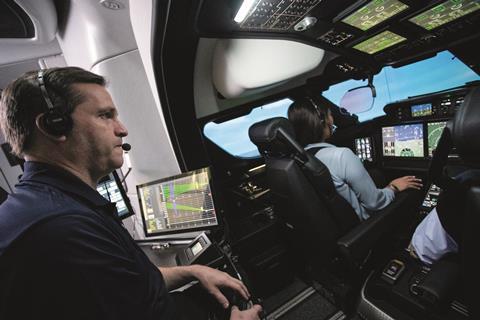Since unveiling the G700 in October 2019, Gulfstream worked diligently to bring its newest flagship to certification. The $75 million jet – a 3m (10ft) stretch of the G650 – has a top speed of Mach 0.935 and a range of 7,750nm (14,353km), and is packed with innovative features to make the pilot’s job easier, including the fly-by-wire, active control sidesticks it shares with its smaller siblings, the G500 and G600.

However, long before the G700 was revealed to the world – in fact, almost from the point at which the aircraft was on the drawing board – FlightSafety International was behind the scenes and in strictest secrecy designing a full-flight simulator and training syllabus for the jet. After years of hand-in-hand progress, FlightSafety delivered the first full flight simulator in September last year, ahead of the RollsRoyce Pearl 700-powered aircraft’s entry into service.
It is a prime example of how the training specialist works in lockstep with business aircraft manufacturers to deliver an exceptional training experience to operators and their pilots. “The OEM relationship is one of the most powerful things to have,” says Richard Meikle, FlightSafety’s executive vice president, operations & safety. “Both of us have a mutual interest in ensuring that every aircraft is flown in as safe a manner as possible and is never involved in an incident.”
Dassault’s latest launch, the Falcon 10X – the French airframer’s contender in the ultra-large-cabin, ultra-longrange segment – is another recent instance of where FlightSafety and an OEM are closely collaborating. In fact, FlightSafety is developing the type’s engineering simulator, along with providing input to Dassault for the iron-bird, a ground-based test rig that manufacturers use to test systems before building an actual prototype aircraft. Being involved in a new aircraft development so early is crucial to understanding the manufacturer’s design principles.
“Almost from the point at which the OEMs decided to go ahead with the airplanes, they started working with us under an NDA [non-disclosure agreement], so we had several years of valuable insight even before the aircraft was announced,” says FlightSafety’s director of safety Mark Kleinhans.
The importance of being fully in tune with the OEM’s philosophy can be seen in the way FlightSafety devised the simulator training programme for the G700. While all modern Gulfstream aircraft share certain cockpit features, many G700 pilots will be transitioning from earlier generation types such as the G450 or G550, which do not have the former’s Symmetry fly-by-wire flightdeck, including the twin active control sidesticks. While these sidesticks reduce workload by providing tactile feedback, informing the pilot of impending flight envelope limits or mode engagements, they require a switch in mindset from a pilot used to flying older Gulfstreams. Additionally, those doing the training must understand and communicate changes in the logic of the older and newer aircraft.
“We were able to work with Gulfstream to build a training programme that embraced those differences,” says Meikle. The close-knit relationship with OEMs works both ways. “The manufacturer uses our simulator as part of their flight test campaign, while our pilots ride along with the OEM’s pilots to really experience what the aircraft is like to fly,” says Kleinhans.
The cooperation also continues after an aircraft’s service entry. A recent innovation by FlightSafety means that anonymised and aggregated data garnered from simulator sessions will be able to be fed back to the airframer. “We effectively become an extension of the OEM,” says FlightSafety’s executive vice-president, sales & marketing Nate Speiser. “We are in every customer discussion round table, so we hear the feedback operators and pilots are giving to the OEM. They might say, for instance, that they need a deeper understanding of how the aircraft performs in wet runway conditions, and we can adapt that back into the training.”
Where FlightSafety also stands out is in its investment in specialist staff. “We have individuals assigned to each OEM, something that we feel adds a lot of value,” says Meikle. “It means we can pick up a phone and get the information we need and deliver it to our customers quickly. To try to get that from someone you have no relationship with and have never spoken to before is significantly harder.”
FlightSafety believes its commitment to delivering quality training, recruiting the right professionals, and a deep understanding of each aircraft are what helps to set the business apart from its competitors. “Rather than focus simply on manufacturing, we see ourselves as a learning company,” maintains Speiser. “It’s something that we have been doing for more than 70 years.”






















